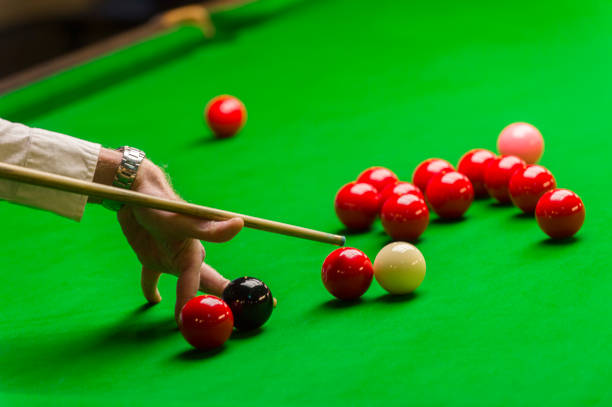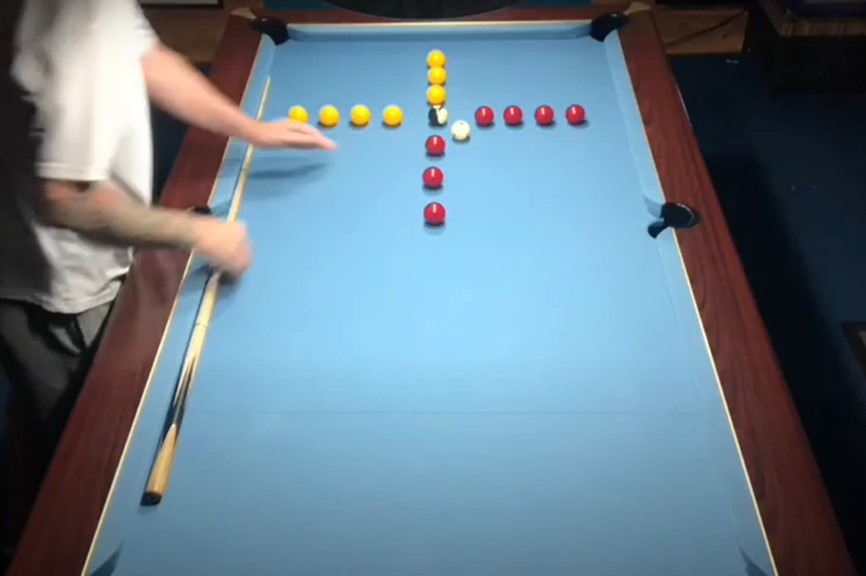To the novice, the extent of cue knowledge may well be limited to its weight and size of tip. To club players and professionals, mention that their cue is ‘just a piece of wood’ and you will get you that look of disdain and contempt. So, what are the attributes of the perfect cue?
Shaft type: Ash or maple?
American pool cue shafts are traditionally made from maple. Carbon fibre shafts are now a modern option. American pool cue shafts have progressed with technology and research over the years providing low cue ball deflection that many players in the professional and amateur game use. Butt designs often includes wraps that can be linen or leather. Wood used in butts, like with English pool cues and snooker cues, is beautiful. Cues can also have inlays in them. For example, ivory use to be an inlay of choice although no longer for obvious reasons. Micarta and mother of pearl are examples of materials used for inlays.
In the UK, you’ll see maple shafts being used by players in the world of English pool, but ash remains the dominant shaft type in pool and definitely in snooker.
Players prefer ash generally for the grain. This grain, or chevrons as can be referred to, players may use to aid in the line-up and aim of their shots. The grain can be tight or wide. The shaft can be stiff or not so stiff. The grain type does not determine the stiffness of the shaft.
Maple, with no noticeable grain, is a denser wood than ash. Maple can provide a more solid feel. Again, the shaft can be stiff or not so stiff.
Some people say that the density of the wood influences cue ball deflection and that maple being denser provides more cue ball deflection than ash.
When said and done, with both ash and maple the full range of shots can be played. Players that pay for custom made cues have also the option of quality of wood for the shaft, be it ash or maple.
Butt
The butt consists of design and diameter.
Butt Design
Some cues will have a front splice and a veneer. Some cues will have four splices. The woods used are often exotic and beautiful to the eye. Amboyna Burl, rosewood, Sa-Lao wood, satin wood, leopard wood, snake wood, birds eye maple, macassar, burwood, white burwood, lava ebony, tulip wood, white ebony and ebony itself to name a few. Often the wood in the butt design and the number of splices has a significant bearing on the price.
Butt Diameter
This is the widest point measured at the bottom of the cue. Butt diameter varies, typically between 29mm and 30mm. They can range as much as 28mm to 32mm. A millimetre, though it doesn’t sound much, makes a difference to the way a cue feels and plays. Butt diameter is important as it can affect how tight you grip your cue. This affects your power and control.
Cue Weight
A cues weight and balance point are closely related. Balance point is talked about next.
Heavier cues can be perceived to give you more power. Not particularly true. Other factors are involved. Heavier cues can make it harder to execute shots that require a softer touch. Some players with technique to work on may find it more difficult to control lighter cues and wobble in their cue action. A cues weight will be customised as part of the design for a new cue. Cues can range in weight from 16.5oz to 20oz, or even outside this range. Typically, most players of all abilities use a cue within the 17oz to 19oz range. Off the shelf cues generally fall within this weight range too.
Balance Point
A well-balanced cue will always feel and play better. Balance points can vary, and custom cue designers/makers have a knack of knowing where that balance point is for that cue. Generally speaking, if a cue has a lower balance point, then the weight of the cue will present itself towards/in the hand that holds the butt end. Balance points further up the cue distribute the weight more evenly and provide players with a better feel. A cue with a balance point in the range of 16” to 17.5/18” will provide a good feel. However, as with everything else discussed here, one size doesn’t fit all.
Cue Length
Along with weight and balance point, cues vary in length. It’s personal. How does it play and feel? The key factor in deciding cue length though is the distance you have between your bridge hand and the cue ball. Another factor being where you like to hold the butt end of the cue. Some players like to hold the cue right at the end as this gives a feeling of being compact and in control. Other players like to have, for example, up to 6” between butt hand and the end of the cue so that they have enough cue to comfortably bridge over balls as and when the need arises. The taller you are, the longer the queue you need is not always true as arm length comes in to play. Also to consider when cueing is whether or not the bridge arm has a bend in it. Typically, a cues length is between 57” and 58”. Cues can be custom made to any desired length, for example, 53” to 63”!
Joint Type
American pool cues are centre jointed. In snooker and English 8-ball the question is, 1 piece cue, ¾ jointed cue or centre-jointed cue? The young beginner will often have a centre-jointed cue usually purchased from a well-known catalogue store or the local sports shop. The more serious player, the club player, top amateurs and professionals are very likely to have a ¾ jointed or 1 piece cue. Simply said, a 1-piece cue provides the ultimate feel when playing a shot. A softer feel due to no joint. A trade off with a one-piece cue is its transportability. They don’t fit easily in the boot of a car or along the back seat. The feedback given is as good as it gets. That said, a ¾ jointed cue that has a quality fitted joint can provide equally good feedback and feel to the player. The vast majority of professional players use a 1-piece cue. With the use of quality materials, custom cues and modern-day cue making practices somewhat eliminate the view that centre jointed cues provide harsher feedback and less feel. A quality, well-made centre jointed cue can play just as well as its 1-piece counterpart.
Tip
Typically speaking 9mm-10mm for tips for snooker, 8mm-9mm for English 8-ball and 12mm-13mm for American 9-ball. Not a hard and fast rule but one to consider for good reasons. A few English pool players use a tip size under 8mm. Some 9-ball players use a tip greater than 13mm. Some snooker players use 10.5mm, some 11mm. The benefit though is questionable. Too small a tip for the code, for example, smaller than 8mm in English 8-ball and you run a greater risk of firing a miscue and your technique and aim has to be faultless. A larger tip size may well provide a more powerful feeling shot; however, you can find yourself with less spin control whereas the smaller tip will provide more spin control. Tip type is perhaps one of the biggest changes that can be made to a cue that will affect feel and playability. Changing a soft for a medium-soft, medium-hard or hard tip will give that cue different playability and feel. A soft tip provides more feel and more spin control. A harder tip transfers more power and results in less spin. A harder tip can hand out more miscues than a softer tip. So many tip brands and types to select from. A bang average pool hall will cues with flat tips, tips hanging off, over hanging and shiny. A quality pool hall will have house cues with far better maintained tips. The leisure player selects a house cue after rolling the cue on the table in a bid to see if it is straight and after inspection of the tip. For the club player, top amateur and professional, tip size and type are absolutely high up on the list for feel and playability. Laminated tips, single layer pressed leather tips and pressed fibre to name a few. Coming in soft, medium-soft, medium-hard and hard the choice is overwhelming. Different brands play different too. Which suits your you? All providing a unique feel, playability and different feedback from shots.
Ferrule
American pool cues ferrules use to be ivory. Amongst the alternatives used are linen based melamine, phenolic ferrules or Micarta. Snooker and English pool cues in the past have and still do come with brass ferrules. Due to recent research, carbon fibre ferrules and titanium ferrules have exploded into the market and onto the cue sports scene. So much so that more and more professionals in snooker and English 8 ball are using them. But why? In a nutshell, carbon fibre and titanium reduce cue ball deflection. John Higgins has made a maximum using a titanium ferrule. They do take some adapting too, especially for the more seasoned player, but players say that the main benefit is that the player can aim closer to the point of contact of the object ball compensating less than you would using a brass ferrule. During a discussion on Eurosport, Jimmy White explained: “With the titanium ferrule, the side doesn’t affect the cue ball until it hits the object ball.
Cue Cost
Custom made cues obviously cost more than a non-customised cue. Everything down to the last detail is discussed and ironed out with the cue maker before they even begin the process of making the cue. Prices then vary dependent upon all the above attributes mentioned above. Butt design, quality of shaft being two of the more costly attributes. Budget is a big consideration. You can pay for an excellent cue or get the best cue that falls within your budget. When all said and done, your cue is personal to you. You can’t tell how a cue will play by its looks. You must try it out. It could be the best cue you’ve ever played!
Chinese 8 Ball Cues and Break Cues
Not mentioned here are Chinese 8 ball cues or break cues. Posts for another day. Although this video may be of interest:
Which Attributes Will Improve Your Game?
So, what in a cue will improve your game? A combination of the above maybe? A new make and type of tip? A carbon-fibre ferrule? Everything can be customised. There are quality cue makers in the UK and worldwide that can change a ferrule on your current cue for example if that’s what you desire to change.
Ultimately, it’s all about the feel, playability and confidence that comes from having the right tools for the job for you. Your perfect cue. An off the shelf cue may be your wand! A new tip and you could have your perfect cue?
Don’t reject a cue on its looks. Try it. Try different attributes. It could lead to you finding your perfect cue.
What Is Your Perfect Cue?
Let us know about your cue: What’s your tip size, make and type? cue weight? cue length? Do you have a 1-piece cue, three quarter jointed, centre jointed cue? What’s your ferrule type?
What, if anything, are you looking to change about your current cue?
raceto11 and its readers look forward to your contributions in the discussions section below.

 How Do You Practise?
How Do You Practise?